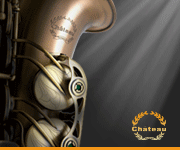 Forgot Username? Forgot Password?
Forgot Username? Forgot Password?
 GRAFTON's History
GRAFTON's History
THE GRAFTON STORY by Wally Horwood
Hector Sommaruga and his Revolutionary Saxophone
The voice on the telephone introduced itself as belonging to Martin Block. Of course 1 knew him or, at least, of him. We had never met but his name and reputation as a highly-skilled musical wind instrument doctor are widely appreciated.
After a few kind words regarding 'Adolphe Sax His Life and Legacy', Martin virtually commanded: 'You must set down for posterity the story of Hector Sommaruga and his plastic saxophone'. With memories of many years ago being stirred, within a few days I found myself spending a pleasant afternoon with Hector and his charming wife Selma (a good saxophone name if there ever was one!) in their cozy Highgate house. There the fascinating tale unfolded and this I will endeavour to pass on…
It is not often that a method of manufacture for musical instruments reaches the headlines in the national and international press. Technology in many fields, mothered by the necessities of the Second World War, had rapidly advanced into everyday lives. As the War ended, synthetic plastics became an ever-increasing part of industry as well as the domestic scene. Even so, the making of a saxophone — of all things — in this new artificial material, after a century in which brass was predominant, caught popular imagination and consequently the attentions of the press. Just as the saxophone itself symbolised the Brave New World envisaged after the Great War, so perhaps its plastic offspring touched the spirit of the new technological age born of the 'forties.
The story really begins in Milan in 1904. The Sommaruga family had their third child and christened him Ettore. The baby's brothers were respectively five and ten years older than he. His father was a cemetery keeper who played the mandolin for his own pleasure if not for that of anyone else. Ettore's mother used to complain that her husband produced a tone like grating cheese!
All of the brothers were musical. From the age of four, Ettore was taught the mandolin by a brother, and later the guitar. He was a shy lad with much musical aptitude. When only twelve, he was apprenticed to a brass musical instrument maker and gained entry into the Scuola Popolare di Musica — the municipal school of music — in Milan. Here his principal study was the flute on which he eventually gained a Diploma in Music — equal top degree — with distinction. He still remembers the thrill of being allowed to play for the first time in a first-class orchestra. His ultimate ambition was to play in the orchestra of La Scala; he spent more time in practising to this end than in practical playing.
In 1922, when Ettore was 18, the Italian dictator, Mussolini, declared in favour of a monarchy, led the Fascist March on Rome and was made Prime Minister. Two months before this came about, Et-tore, not caring for the political climate, left his native city for Paris. He got a job in a musical instrument factory and found himself working on French horns in a process which involved pushing the tubes directly onto mandrils instead of filling them with lead, bending and beating in the traditional style.
It was here that Ettore's lifelong interest in the saxophone began. The establishment was a small one handling all types of wind instruments which came in for repair. These included saxophones then becoming the rage of the popular music scene and to which this young man with woodwind training was naturally drawn. He enquired about lessons and was soon practising the instrument under the guidance of a military bandsman.
Saxophones of the day were generally silver-plated and of a dull appearance out of keeping with that brash time. Gold-plating was coming in and, for this to be achieved on an existing instrument, there had to be a complete dismantling before plating, reassembly and fine tuning.
An approach was made by Geoffrey Hawkes, principal of the famous house of Hawkes and Son (now absorbed into Boosey and Hawkes Limited). Ettore, in 1926 at the age of 22, knowing no English, was transported to London with an official contract to carry out this re-plating process and to teach four young British boys to do the same. The very first thing to happen was that 'Ettore' was anglicized to 'Hector' and as Hector he is and for ever will be known.
Hector was a personable young man who made friends easily. He was taken under the wing of John Pausey of the Hawkes top management and, with his wife Connie, generally fathered and mothered him. He still recalls John with great affection as a quiet man in all his pursuits except when watching his favoured Fulham football team. Then he would be transfigured into a veritable demon!
With that exception, John gave an impression of being rather strait-laced. It was Hector's practice to return frequently to Paris on short trips to see friends and to sort out any technical problems. John Pausey also had business in Paris and made good use of Hector as an interpreter. On one occasion, Hector and his Parisian friends got John along to the Folies Bergère. The Englishman was, as usual, very quiet and it was thought that the performance might have offended him. Yet, on their return to England, he was overheard relating his experiences in great detail and with obvious relish.
Hector's work permit was for six months; his wage was four pounds, ten shillings (£4.50) a week. After only two weeks, this was raised to five pounds and the permit extended to a full year. Then he handed over to an assistant whom he had trained.
In retrospect, Hector says that the three great influences on him during his year in England were Geoffrey Hawkes, John Pausey and the American oboist and bandleader, Van Phillips. This musician had come over to give concerts, which included Rhapsody in Blue, at London's Plaza Cinema. In exchange for French lessons, Van Phillips taught Hector jazz-style playing on the saxophone.
Returning to Paris in 1927, he continued to gain experience with French and American saxophones and recalls an opinion that Buescher was the best alto and Conn the best tenor at that time.
Before leaving England, Hector, in company with John Pausey, had joined a jazz-style dance band, playing alto saxophone and getting used to reading the distinctive type of notation. In Paris, he grew tired of the workshop and took to being a full-time professional saxophonist. The custom then was for musicians to be under contract to a particular establishment. He was engaged to play at a Russian night-club which had three bands — Gypsy, Argentinean and a 7 or 8-piece American combination. Hector's outfit was called 'Her Old Darlings'. Later he played in a larger band at the Lido, accompanying the famous cabaret.
After some years of playing in and around Paris, he went to the Riviera. Eventually he decided he didn't much like the clientele in the night clubs and by 1934 was anxious to get away. He married a girl whose mother was French and father English before making a move to Lisbon. This was in anticipation of good business opportunities coupled with a congenial climate.
In Estoril, he opened a music shop specializing in jazz instruments and records and was pleased with his initial volume of sales. That was before he discovered that the Portuguese really had no money so that his accounts were seldom paid. He stuck out for two years before selling up at a considerable loss.
By this time, the Spanish Civil War was at its height. The same hatred of Fascism which had made him leave his native Italy in 1922 again drove him from the Iberian peninsular. 1936 found him back in England where, from his wife's home in Sussex and with two helpers, he ran a home for child refugees from Spain. As the war ended and the children returned, he continued with Jewish children from Nazi Germany.
All through this, Hector had retained his Italian citizenship. Ironically, when the United Kingdom went to war with Germany in 1939, he found himself interned as an enemy alien on the Isle of Man. From his hotel room on Douglas sea-front, he organized an internee's orchestra whilst petitions signed by some notable people agitated for his release.
After three months this was granted. He returned to London and moved freely about without trouble. He played a pacifist role being sent to a training centre in Croydon to have his engineering skills put to the making of surgical instruments. In 1942, with an Italian partner, he set up independently to make surgical instruments only to find that excellent instruments were coming in from India, so there was no call for his!
Yet things were moving towards the key point of this story; the premises he took for his small factory were in Grafton Way, off Tottenham Court Road. And 'Grafton' was hereafter to be an important name in his life.
At first things looked black. His marriage broke up and his manufactures were not wanted. Then John Pausey pointed out that, since no new musical instruments were being made or imported, there could be good business found in repairing instruments for the armed forces.
This proved to be his salvation, despite enormous difficulties brought about by wartime conditions and the intensive bombing of Central London. His fortunes improved to the extent that a tempting offer came from Ben Davis. Ben and his brother Lew were luminaries of the London dance-band scene on saxophone and trombone respectively. At that time, they owned Selmer (London) Limited and held the sole agency for the distribution of Selmer (Paris) instruments in Great Britain.
But Hector preferred his independence. He was a fine worker in brass, and with a growing reputation, he formed the Grafton Light Engineering Company Limited, moving to bigger premises at No. 85 Tottenham Court Road. Included in the move were Martin Block, the inspirer of this piece, who had come to work at the bench, and Selma whom Hector eventually married.
Martin was then but sixteen years of age. This was his first job; he was taught the elements of woodwind repair craftsmanship by Hector. He stayed for about a year and a half; then — as he now says — 'knowing it all', set up in business on his own account in partnership with a friend. This continued until the time came for him to fly with the RAF towards the end of the war.
As the War entered its final phase, Hector, as a competent and enthusiastic engineer, was aware of the emergence of synthetic plastic as a manufacturing medium. Brass in sheets and tubes was expensive and scarce; it needed expensive skills to fashion a musical wind instrument. Against this, he perceived that moulded plastic would be cheap and eminently adaptable to mass production.
Although he then could not have known it, popular music still had a decade or so to go in the hands of real musicians. After that, it was to be taken for a time into the hands of over-paid, over-amplified, under-talented amateurs. Or so it seemed at that time, before professionals reasserted themselves. The saxophone was still the mainstay of the dance band so that, when Hector turned his inventive talents towards the making of saxophones in plastic, he sensed a ready sale by bringing a first-class instrument at a modest cost within the reach of almost anyone.
As the War ended, the idea had already been developed to the point of filing a Patent Specification at the Patent Office in London. Provisional Specifications Nos. 604,407 and 604,418 were applied for on 14th September 1945, with Complete Specifications being left on 13th December 1946 and 13th January 1947. These were finally accepted on 2nd July 1948.
The narrative accompanying the applications outlines the conventional methods of saxophone manufacture in brass whereby, after the body is formed, a multitude of components (pillars, needlespring-housings, key-guards, thumb rests, sling ring and the like) need a high degree of skill in the making and brazing. He goes on to mention the limitations of plastic moulding, showing how difficulties could be overcome by careful design. This would incorporate all protruding parts in the basic moulding in such a way as not to cause difficulties in the extraction from the mould. In doing this, he reduced the number of pillars from around thirty to ten, altered their shapes and positions on the body and designed a new spring system. There were a lot of other modifications resulting in a completely new method of manufacture which only a high intellect allied to instrumental and engineering skills could have conceived.
A practical manufacturing scheme was evolved to produce the following individual parts prior to assembly: (i) the body, (ii) the bell in two parts, (iii) two key guards, (iv) a brass mouthpiece (it proved too difficult to attach a conventional mouthpiece to a plastic mouthpipe), (v) some of the pillars, with all supports incorporated in the main mould, (vi) a redesigned, simplified key mechanism working as efficiently as with a brass saxophone but with a new type of spring to replace needles. A hand made, unplayable prototype was ready for the Britain Can Make It exhibition of 1946 — a prestige item 'built for better times ahead', to demonstrate economies in time and attractiveness in appearance that plastic manufacture could offer. The great engineering firm, De La Rue, did the moulding using powder produced by Imperial Chemical Industries. It was the largest piece of injection moulding attempted up to that time.
In launching the instrument commercially, finance and entrepreneurial backing was essential. Geoffrey Hawkes would have liked to participate but feared that he would not be able to carry his Board of Directors with him. Finally John E. Dallas Limited agreed to cover wages and costs whilst the concept was being developed to the point of commencing production.
This process took six years. Finally, in 1950, the instrument was launched in a blaze of publicity. It was described as 'A Tone Poem in Ivory and Gold' to sell at '55 guineas' — just under £58 — which was about half the price of a comparable saxophone in brass.
'The Superb Grafton Acrylic alto — endorsed by every eminent player and authority' — ran the advertising blurb. This was not far from the truth. The young John Dankworth, who seemed to top every Melody Maker poll at that time both as an alto saxophone player and with his celebrated 'Johnny Dankworth Seven', was introduced to the plastic instrument at an early age. He discussed it in detail with the inventor, making several useful suggestions.
The inventor's enthusiasm for the project was infectious. Dankworth was provided with a prototype with which to familiarize himself and quickly established a faith in the validity of the instrument. Young and forthright as he admits to being and influenced by nothing more than his good opinion, he elected to use the instrument exclusively for upwards of a year in all performances including broadcasts.
A photograph in Melody Maker of 20th May 1950 shows John Dankworth in earnest conversation with Hector Sommaruga with a Grafton alto between them. This was in the same week as the Dankworth Modern Music Club had been opened and the plastic saxophone played, probably for the first time in public.
On the original advertising broadsheets, the photographs of no less than fifteen leading British saxophonists appear. In addition to Dankworth the now-legendary Freddie Gardner is reported as using the Grafton when soloing with Peter Yorke's 50-piece Concert Orchestra. Other notable advocates were Ronnie Chamberlain, Joe Crossman, Ivy Benson (of the All-Girls Orchestra fame) and Bill Lewington (in days before he became a most successful instrument distributor). Together with Leslie Evans, a leading saxophone teacher, all paid tribute to the instrument's excellent intonation, tone, mechanical action, dynamics, harmonics and appearance.
John Dankworth recalls his own reactions to the instrument at a time when he was using it daily in the full glare of publicity:
As a performing instrument I found it totally adequate for my needs at the time. In spite of my success at the polls as a saxophone player, I never deceived myself into thinking that I was anything approaching a virtuoso player. I have always adjudged myself to be a creative musician rather than a spectacular instrumentalist. However, I obviously needed an instrument which would respond quickly and faithfully to my requirements.
There were two major differences between the Grafton and a conventional saxophone. Firstly, the extra thickness of the plastic body made for a slightly 'tubby' feel when holding the instrument. This in turn made a conventional saxophone feel rather 'emaciated' when one went back to it. I do not however think that this had any effect on finger technique but merely required a short acclimatization period when returning to a metal sax.
The other difference was more of a concern to a saxophone player used to a metal instrument. Needle springing was for technical reasons impossible and was replaced by a system of piano-wire springing which led to a completely different 'feel' for the action. Because the springing was lighter in tension, there was, theoretically at least, the possibility of a much faster technique on the Grafton. But it was essentially a different technique and it meant that it was almost impossible to transfer finger dexterity to a conventional instrument without a great deal of reorientation. Towards the end, for some reason, I found that this lack of resistance in the action was something that began to bother me and I was eventually tempted back to a conventional sax.
The technical trade too was proud of the achievement. British Moulded Plastic Limited had an advertisement in The Times of 30th December 1950 which drew attention to their plastic moulding process as applied to the saxophone, offering their services and expertise in any similar application.
Ade Monsbourgh was feted as playing a Grafton in a well-reviewed recording with the Humphrey Lyttelton Band. Its appearance must have recommended it to the showman-bandleader, Rudy Vallee, who was among the first to use it in America and, on a higher musical plane, Ornette Coleman did the same. Charlie Parker, forbidden under contract to us it in the United States, did play it publicly on a tour of Canada.
The world of art music also looked favourably on the Grafton. Its first appearance with a symphony orchestra was probably when Frank Black, who was the musical director of the Branksome Tower Hotel Orchestra, played it with the Bournemouth Municipal Orchestra in a performance of Vaughan Williams' Job at the Winter Gardens in 1950. It is also reported that Leslie Newland used a Grafton with the Halle Orchestra in Manchester.
Outside of the musical firmament, quite a few column-inches were given over to the instrument in the national press so that the attentive, even if nonmusical, reader would have been aware of its existence.
With so much going for it, success in both commercial and aesthetic terms must have been assured.
Yet it didn't happen. No one makes or plays plastic saxophones today and original Graftons are now collectors' pieces.
Why did it fail? Why did its brilliant inventor in 1953 become so disheartened that he severed his connection with the Dallas Company to return to his 'spiritual home' on the French Riviera, there to run a motel and manufacture wooden chalets for the rest of his working days?
The reasons for the failure of the Grafton Acrylic alto saxophone are manifold. As it turned out, for all the good points which could be listed, there was an equally long list of drawbacks.
To achieve volume sales in support of mass-production, it was envisaged that schools would take substantial numbers and there would be a thriving export trade, especially to the United States of America. The latter point was crucial and was one of the most important facets of the project's failure. It appears that American traders, fearful of the effect of this cheap instrument on their sales of standard instruments got together to boycott it. A story got around that a Grafton alto in the hands of Ornette Coleman literally fell to pieces in his hands on the stage. In fact, the plastic saxophone was really robust. It could be that this was a 'sour-grapes' invention put around by interested parties to discredit the instrument.
Then there was the appearance of the Grafton milky white with golden keys. Musicians are perhaps more prone than most to an innate conservatism, and on the whole tend to shy away from things which appear to offend tradition. The plastic instrument did, of course, appeal to the showman but even here its charm was limited. Experiments were carried out to produce a tenor saxophone but this proved too much for the moulding processes of the time. It follows therefore that a baritone saxophone was quite out of the question. Leaders of stage and other bands objected to an unmatched saxophone team especially as it made the alto players appear to be something special against the other equally important members of the section.
It was also said that instruments in plastic and in brass did not voice well together. This is difficult to substantiate since so many authorities testify clearly that they were unable to differentiate between them in tone. Leslie Evans remarks on the fact that many of his pupils thought the tone quality extremely good. On several occasions he conducted experiments with he himself playing on plastic and metal instruments alternately out of sight of the listeners. At no time could anyone tell the difference.
The body of the instrument was quite tough and very cheap to produce. If it were dropped, it might crack and repairs presented something of a problem. Because of the unconventional body and mechanism with its wire-wound springs, repairers refused to tackle them or would do so only under protest. The Dallas Company had a repair service. If an overhaul were required, the Company merely took the instrument into its workshop and immediately handed out in exchange either a new or fully reconditioned one. It is recalled that the cost of this service was around fourteen pounds.
Other technical disadvantages were that the side and rear key guards were plastic attachments and were easily snapped off. Further, there were too many 'adjusting screws' — fine in a comfortable environment with a well-cared-for instrument but an infernal nuisance to a player on the road where the instrument had to take occasional knocks and rough treatment.
Having said all that, with reasonable care many instruments gave excellent service over many years. There are many Graftons still about which, with the minimum of maintenance, are in good, playable condition.
The final word on the cause of the Grafton's failure should go to Hector Sommaruga, its inventor. Looking back over three or four decades he feels that building down to a price was a mistake. The motive was, in his case, extremely worthy in the desire to bring a good instrument within reach of all. All the same, he could have overcome many of the disadvantages had there been more money available to spend on quality. It could be that the Grafton arrived on the scene about twenty years too early.
With Hector's departure in 1953, the Dallas Company persevered with what they had and actually brought out a clarinet made on the same lines as the alto saxophone. This was an abject failure right from the start. Leslie Evans recalls that he was not at all impressed with its performance and suggests that the internal dimensions, more critical on the cylindrical clarinet than on the conical saxophone, had something to do with it. In all events, he never wanted to sell one — and never did! Bill Lewington adds that the white and gold colour, when applied to the 'classical' clarinet, was altogether too bizarre and, to many people aesthetically offensive.
Alan Lucas, woodwind exponent and teacher, and well-known over many years as a very successful sales director in the musical instrument industry, gives his own opinions and tells of the end of the Grafton Acrylic alto saxophone:
When it was introduced, I was among the many teachers who were quite prejudiced against plastics. I don't know why. This was a usual conservative approach. I didn't much come up against it until I joined John Dallas Limited as Director in charge of production.
When I came to the factory, there remained the whole of the production line complete with tools and everything else. This was in September 1967 when the line was still complete. Manufacturing had stopped; there was nobody assembling but we did have the parts of about a hundred instruments which we farmed out to an assembler (whose name I can't recall) who put the pieces together. The price was reduced to clear.
I was very interested in preserving all the tools and jigs because I thought that somebody sometime would reopen the manufacture. They were all put together in a cupboard.
The next year, I took over another job in the company and had gone out promoting in the educational field. I left the factory and, to my horror when I got back, I found that the people who were in charge not knowing what they were doing, had sold the whole issue for scrap. That was in /968 — and that was the end of the Grafton! They will never be made again on the same pattern — no one would ever reactivate the tools and materials necessary to start a production line.
I saw samples of the plastic clarinet long before going to work for John Dallas. I was not impressed. Like most professional players then, I was inclined to look upon it as a gimmick.
The saxophone intonation was very good. The only thing that worried me about it was that I thought the plastic resin was rather thin.
The last conversation I had with Hugo Schreiber in Germany in 1972 was when he asked what had happened to the tools, since a European manufacturer was interested in tracing them. I knew they had gone to the scrapheap. That was the final ignomy!
Of course, brass continued to be used for saxophone as well as for orchestra and band instruments of the brass classification. But plastics didn't go away. With new materials and techniques being developed it was toward the woodwind section that they were directed.
Bill Lewington, whose close contact with wind instruments of all types, makes and materials is unrivalled, points to the paradox: 'The worst material for the construction of woodwind instruments is wood! It is an unpredictable material which is subject to many changes and movements due to humidity and temperature variations. It must eventually give way to a more stable, inert material.'
This process is well on the way to realization. Recorders, piccolos, oboes, clarinets and bassoons are freely available in the new plastics and, for the sake of lightness they have been successfully applied to the bells of larger brass instruments, particularly the sousaphone.
Open-minded musicians detect no deterioration in sound quality attributable to the use of plastics. Indeed, many will testify to an improved brightness and more fluent emission of sound due to the high polish attainable on the bore. As natural conservatism is overcome, it would seem that wood may eventually disappear altogether in the manufacture of woodwind instruments.
In this event, we come full circle back to Hector, a musician with a brilliant engineering mind so reminiscent of the same attributes possessed by the original inventor of the saxophone. Working almost exactly a century after Adolphe Sax's famous first patent for the instrument, Hector was the first to apply an entirely revolutionary process in saxophone manufacture. His apparent failure at the time opened up an entirely new concept which led the way to the outstanding successes achieved by synthetic materials today.
And so we salute a man without whom no history of the saxophone would be complete — a genial genius — Hector Sommaruga and his revolutionary Grafton Acrylic alto saxophone.




